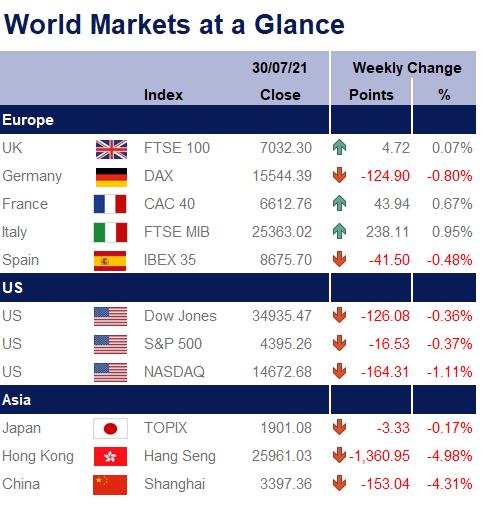This week’s big event was Wednesday’s (28 July 2021) Fed monetary policy meeting – and given the recent conflicting views from a number of individual Fed policymakers, we were all over the statement and accompanying press conference, looking for clues and any subtle changes in the wording covering growth and inflation, which would help us formulate when the central bank is likely to start tightening monetary policy.
On inflation, we have been repeatedly saying in these Market Summaries, that a sharp rise in inflation is a foregone conclusion due to distortions caused by the impact of last year’s coronavirus and sudden lockdowns, coupled with today’s supply constraints caused by the economic reopening – and as such these high inflation readings would quickly fade as the distortions pass through, rather than result in persistently high inflation.
And much to our relief, the Fed Chair, Jay Powell, thankfully dismissed the recent high inflation readings by stating that inflation was confined to just a few specific sectors and should start to slow in the coming months.
The big difference in the meeting’s statement was the removal of the word “substantial” in regards to wanting to see substantial further economic progress – which reflects the recent strong economic data. However, in the accompanying press conference, Jay Powell used the word several times in reference to the employment market.
As the Fed has a dual mandate covering inflation and employment, we see this as a clear indication that while the US economy may have moved a step closer to justifying a tapering of its QE (quantitative easing) programme, it was only a baby step, as their focus is very clearly on helping the employment market recover.
Additionally, Jay Powell said that discussions on QE tapering will occur during “coming meetings”, which we believe is a clear indication that the Fed is unlikely to announce any tapering plans until their meetings in November or December at the very earliest – and as such we continue to believe that the Fed is a long way away from increasing interest rates, which is positive for global equity markets.
Given the Fed’s focus is clearly on the US employment market, this coming Friday (6 August 2021) will be a key focus with data covering non-farm payrolls; unemployment rate; participation rate; and average earnings.
Other important data releases in the week ahead include: US ISM and factory orders; Chinese PMI and import/export data; and Eurozone retail sales.
Additionally, we have a BoE monetary policy meeting on Thursday (5 August 2021).
Investment Management team


